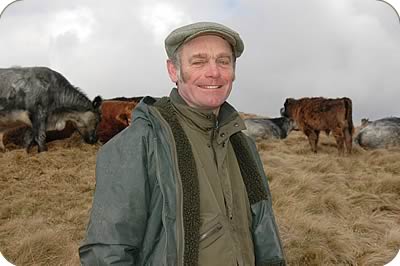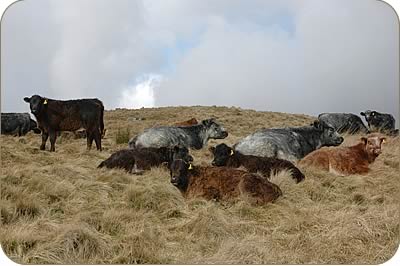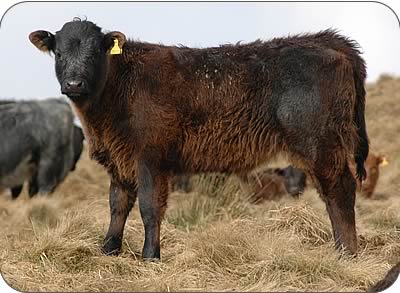Jennifer MacKenzie is an agricultural photo journalist with almost 30 year's experience. Operating from her base in Cumbria, Jennifer undertakes mainly industry-related freelance writing and photography.
Traditional cattle breeds graze conservation sites
The Whitebred Shorthorn and its Galloway cross daughters suit the windswept acres of Hotbank Farm, near Bardon Mill which straddles the Roman Wall.
 |
| John Pattinson |
Not only do the hardy, traditional cattle stand up to the elements even when outwintered with little supplementary feed, they are also helping to contribute to the environment on this World Heritage site.
Tenants of the National Trust, John Pattinson, his wife Pamela and their son Jonjo farm the severely disadvantaged Hotbank and Cragend in compliance with many organisations including the Northumberland National Park, English Heritage and English Nature.
The Pattinsons farm a total of 1,500 all-grass acres, including grass parks, principally on what was originally three holdings which stretches for three miles and is half a mile wide. All the land is in Countryside Stewardship with the exception of one field.
They run 100 cows, half being Galloways and the remainder Blue Greys, plus five pedigree Whitebred Shorthorns.
During 2005 and into the second year, cows and calves had been grazing land previously a game park in a project run by the Northumberland National Park to encourage heather re-generation by eating the dominant purple moorgrass.
The project, which ended in the autumn of 2005, was aimed at encouraging grazing with traditional breeds of cattle on sites of nature conservation value, while researching and promoting the cultural history of cattle within the national park.
Observations have suggested that the purple moorgrass has become less dominant as a result of the cattle grazing it although this will be verified with a survey this year.
 |
| Bluegrey cows with their Limousin X calves |
John Pattinson’s father Joseph was a member of the committee which founded the Whitebred Shorthorn Society in the 1960s and the breed has been integral to the system at Hotbank since then.
“I tried using continentals on the Galloways but it was a lot of work with often difficult calvings and they only lasted half as long as the Blue Grey cow,” said John Pattinson.
“They were bigger cows which ate more and made more of a mess of the land. While we got a good price for the calf, it took a lot of hard work to get there,” he added.
“The advantages of the Blue Grey and the Whitebred are that they can be outside and do well with very little to eat.”
However, during foot and mouth in 2001, the Hotbank herd of Whitebreds was almost wiped out in the cull.
Fortunately, a new bull, bought from Gordon Jackson, of Blackburn, was wintering in a field away from the main part of the farm with one of the herd’s cows.
Hotbank Lucy 14, whose bloodlines go back to one of the herd’s foundation cows, was saved, although the rest of the cattle and the farm’s flock of North of England Blackface sheep were taken in the cull.
 |
| Limousin X Blue Grey calf |
Of the Galloway herd, between 20 and 30 are bred pure but unregistered with the remainder crossed with the Whitebred to produce Blue Greys. Most of the cows calve in the spring outside on land up to 1,100ft above sea level, finding their own shelter.
Blue Grey calves were sold at Bellingham mart but since its closure all are sold at about 18 months old through Newcastleton’s annual sale at the end of October.
The Blue Grey cows are crossed with the Limousin bull and calves are sold at the Longtown hillbred suckled calf sale with prices averaging £400 for bullocks.
Blue Grey bullocks are sold at Longtown mart’s Kirkcambeck sale at 18 months old.
“The Blue Grey is attracting increasing interest partly because of its eatability. We eat two Galloways or Blue Greys every year and you can’t beat the meat for taste and tenderness,” said Mr Pattinson.
“I think the Blue Grey is as good to eat as the Galloway. They are reared slowly and naturally at Hotbank on hill pastures with no artificial fertilisers, not even on our 100 acres for hay because of Countryside Stewardship, only farm yard manure.”
The Whitebred Shorthorn passes on its trait of extra milkiness which combined with the hardiness of the Galloway produces an animal with hybrid vigour which is very low maintenance, says John Pattinson.
“The Blue Greys are fertile and prolific producing a calf a year and lasting twice as long as other suckler cows. One we sold lived until she was 22 and produced a calf each year.
“Whitebred Shorthorns are also long-lived with cows at 12 years plus being quite usual.
“Native cows like the Whitebred, the Galloway and the Blue Grey are smaller and lighter in weight causing less damage to areas of rough grazing such as that in Drovers Project.
“They did very well off the 130 acres and came off in fine fettle in late summer. The grass doesn’t grow until June but the purple moorgrass has a high feed value which older generations used to cut for hay,” said Mr Pattinson.
From a small nucleus of around 50 away wintered hoggs, the Scotch Blackface flock now numbers 600 breeding ewes.
The Pattinsons paid £15,000 for a shearling ram at Hexham to help achieve standards of the flock pre foot and mouth, a price well over the previous centre record of £11,000.
Half the flock is put to Bluefaced Leicester rams bred on the farm. Both Bluefaced Leicester shearling
